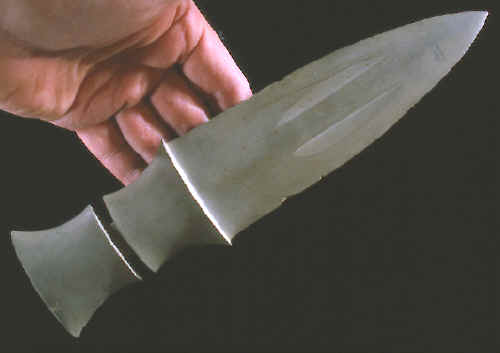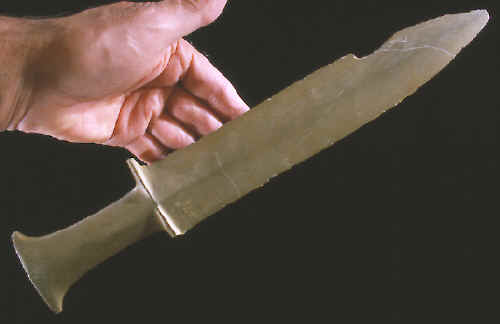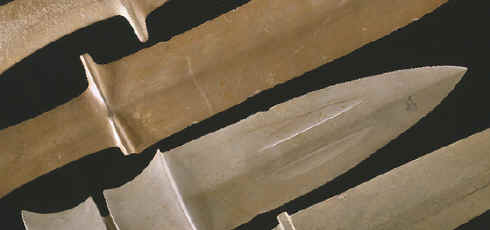|
ABSTRACT:

GROUND SLATE DAGGERS
PLAIN POTTERY
CULTURE--ASIA
Ground slate daggers are found in Korea, northeastern
China and
the southern Russian Federation maritime province
and to the
south in western Japan. They represent some of the most skillfully
crafted slate artifacts ever manufactured by a Stone Age culture
anywhere in the world. The more
elaborate examples were apparently used as ritual objects but other
more plain examples may have been used as weapons. An estimated date
for these daggers is sometime between 1,000 to 300 B.C.
The daggers described in this article are in private
collections. The four larger examples are in the Floyd Ritter
collection.
The text of this article was written by Charles T. Keally.
Professor Keally has been teaching part-time courses in physical
anthropology and archaeology at Sophia University in Tokyo, Japan
since 1971 and full time since 1982. |
"Many
archaeologists consider ground slate weapons to be copies of bronze
weapons."---Charles T. Kealy 1991

ground slate daggers
by Charles T.
Keally
Ground slate arrowheads and daggers are characteristic of the Korean Plain
Pottery culture, dated roughly between 1,000 and 300 B.C. These
distinctive stone artifacts are found over most of the Korean peninsula,
and a few examples are also found on sites just to the north in
northeastern China and the southern Soviet (Russian Federation) maritime province, and to the
south in western Japan, where they are dated to the early half of the 1st
millennium B.C.
|

CLICK ON
PICTURE FOR LARGER IMAGE
GROUND SLATE DAGGER
KOREAN PLAIN POTTERY
CULTURE
ASIA
FLOYD RITTER COLLECTION
This is the best preserved and most elaborate dagger out of the five
illustrated in this article. The blade edges are sharp and the carving
on the handle and blade are very well done. This dagger measures 10
inches (25.3cm) long. |
Many
archaeologists consider ground slate weapons to be copies of bronze
weapons, and consequently assign the Plain Pottery culture to the Korean
Bronze Age. Other archaeologists suggest these slate weapons evolved from
chipped stone antecedents and were made before bronze came into common
use. These slate weapons are found in village sites and in burials, and
they perhaps served both practical and ritual purposes. Some of the
daggers, however, are so elaborate and unwieldy that they could have
served only ritual purposes.
|

CLICK ON
PICTURE FOR LARGER IMAGE
GROUND SLATE DAGGER
KOREAN PLAIN POTTERY
CULTURE
ASIA
FLOYD RITTER COLLECTION
This dagger is heavily patinated. The slate is actually very dark on
the inside as can be seen where the edges have been chipped. This large slate
dagger measures 13 11/16
inches (35.4cm) long. |
Bronze objects first
appeared in Korea about 1,000 B.C. or a bit earlier, but bronze casting
began only around 700 B.C. Iron appeared about 400 B.C. The appearance of
iron seems to mark the end of the use of ground slate weapons in Korea,
and also of the period referred to confusingly as both the Plain Pottery
culture and the Bronze Age.
|




